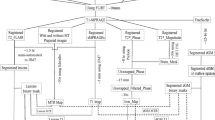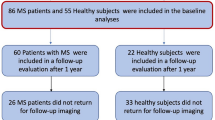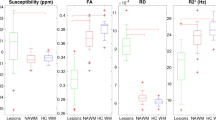Abstract
The aims of this study were to improve, using a 3.0 Tesla (T) scanner and diffusion tensor (DT) magnetic resonance imaging (MRI) with sensitivity encoding, our understanding of: 1) the possible pathological substrates of normal-appearing white matter (NAWM) and grey matter (GM) damage in multiple sclerosis (MS) and 2) the factors associated to WM and GM atrophy in this condition. Conventional and DT MRI of the brain were acquired from 32 relapsing-remitting (RR) MS patients and 16 controls. Lesion load, WM (WMV), overall GM (GMV), and neocortical GM (NCV) volumes were measured. NAWM mean diffusivity (MD) and fractional anisotropy (FA), and GM MD were calculated. GMV and NCV were lower (p ≤ 0.001) in MS patients than controls, whereas WMV did not differ significantly. MS patients had higher NAWM and GM average MD and lower NAWM average FA (p ≤ 0.001) than controls. Moderate correlations were found between intrinsic lesion and tissue damage with both GM volumetric and diffusivity changes ()0.41 ≤ r ≤ 0.42, p ≤ 0.04). DT MRI and volumetry measurements at 3.0 T confirm the presence of NAWM and GM abnormalities in RRMS patients. Although histopathology was not available, axonal and neuronal damage and consequent reactive glial proliferation are the most likely substrates of the changes observed.
Similar content being viewed by others
References
Ashburner J, Friston K (1997) Multimodal image coregistration and partitioning- a unified framework. NeuroImage 6:209–217
Barbier EL, Marrett S, Danek A, Voermeyer A, van Gelderen P, Duyn J, Bandettini P, Grafman J, Koretzky AP (2002) Imaging cortical anatomy by high-resolution MR at 3.0 T: detection of the stripe of Gennari in visual area 17. Magn Reson Med 48:735–738
Basser PJ, Mattiello J, LeBihan D (1994) Estimation of the Effective self-diffusion tensor from the NMR echo. J Magn Reson B 103:247–254
Bo L, Vedeler CA, Nyland H, Trapp BD, Mork SJ (2003) Intracortical multiple sclerosis lesions are not associated with increased lymphocyte infiltration. Mult Scler 9:323–331
Bo L, Vedeler CA, Nyland HI, Trapp BD, Mork SJ (2003) Subpial demyelination in the cerebral cortex of multiple sclerosis patients. J Neuropathol Exp Neurol 62:723–732
Charil A, Filippi M, Falini A (2006) High-field strength MRI (3.0 T or More) in white matter diseases. In: Salvolini U, Scarabino T (eds) High field brain MRI - Use in clinical practice. Springer, Berlin Heidelberg New York
De Stefano N, Matthews PM, Filippi M, Agosta A, De Luca M, Bartolozzi ML, Guidi L, Ghezzi A, Montanari E, Cifelli A, Federico A, Smith SM (2003) Evidence of early cortical atrophy in MS: relevance to white matter changes and disability. Neurology 60:1157–1162
Filippi M, Rocca MA (2003) MRI aspects of the “inflammatory phase” of multiple sclerosis. Neurol Sci 24 (Suppl 5):S275–278
Filippi M, Cercignani M, Inglese M, Horsfield MA, Comi G (2001) Diffusion tensor magnetic resonance imaging in multiple sclerosis. Neurology 56:304–311
Geurts JJ, Bo L, Pouwels PJ, Castelijns JA, Polman CH, Barkhof F (2005) Cortical lesions in multiple sclerosis: combined postmortem MR imaging and histopathology. AJNR Am J Neuroradiol 26:572–577
Hartkens T, Rueckert D, Schnabel JA, et al. (2002) VTK CISG registration toolkit: an open source software package for affine and non-rigid registration of single- and multimodal 3D images. Springer-Verlag, BVM, Leipzig
Jaermann T, Crelier G, Pruessmann KP, Golay X, Netsch T, van Muiswinkel Am, Mori S, van Zijl PC, Valavanis A, Kollias S, Boesiger P (2004) SENSE-DTI at 3 T. Magn Reson Med 51:230–236
Kim DS, Garwood M (2003) High-field magnetic resonance techniques for brain research. Curr Opin Neurobiol 13:612–619
Kurtzke JF (1983) Rating neurologic impairment in multiple sclerosis: an expanded disability status scale (EDSS). Neurology 33:1444–1452
Kutzelnigg A, Lucchinetti CF, Stadelmann C, Bruek W, Rauschka H, Bergmann M, Schmidbauer M, Parisi JE, Lassmann H (2005) Cortical demyelination and diffuse white matter injury in multiple sclerosis. Brain 128:2705–2712
Miller DH, Barkhof F, Berry I, Kappos L, Scotti G, Thompson AJ (1991) Magnetic resonance imaging in monitoring the treatment of multiple sclerosis: concerted action guidelines. J Neurol Neurosurg Psychiatry 54:683–688
Miller DH, Thompson AJ, Filippi M (2003) Magnetic resonance studies of abnormalities in the normal appearing white matter and grey matter in multiple sclerosis. J Neurol 250:1407–1419
Nagae-Poetscher LM, Jiang H, Wakana S, Golay X, van Zijl PC, Mori S (2004) High-resolution diffusion tensor imaging of the brain stem at 3 T. AJNR Am J Neuroradiol 25:1325–1330
Peterson JW, Bo L, Mork S, Chang A, Trapp B (2001) Transected neurites, apoptotic neurons, and reduced inflammation in cortical multiple sclerosis lesions. Ann Neurol 50:389–400
Polman CH, Reingold SC, Edan G, Filippi M, Hartung HP, Kappos L, Lublin FD, Metz LM, McFarland HF, O'Connor PW, Sandberg-Wollheim M, Thompson AJ, Weinshenker BG, Wolinski JS (2005) Diagnostic criteria for multiple sclerosis: 2005 revisions to the “McDonald Criteria”. Ann Neurol 58:840–846
Pruessmann KP, Weiger M, Scheidegger MB, Boesiger P (1999) SENSE: sensitivity encoding for fast MRI. Magn Reson Med 42:952–962
Rovaris M, Gass A, Bammer R, Hickman SJ, Ciccarelli O, Miller DH, Filippi M (2005) Diffusion MRI in multiple sclerosis. Neurology 65:1526–1532
Smith SM, De Stefano N, Jenkinson M, Matthews PM (2001) Normalized accurate measurement of longitudinal brain change. J Comput Assist Tomogr 25:466–475
Studholme C, Hill DLG, Hawkes DJ (1999) An overlap invariant entropy measure of 3D medical image alignment. Pattern Recognition 32:71–86
Author information
Authors and Affiliations
Corresponding author
Rights and permissions
About this article
Cite this article
Ceccarelli, A., Rocca, M.A., Falini, A. et al. Normal-appearing white and grey matter damage in MS. J Neurol 254, 513–518 (2007). https://doi.org/10.1007/s00415-006-0408-4
Received:
Revised:
Accepted:
Published:
Issue Date:
DOI: https://doi.org/10.1007/s00415-006-0408-4




